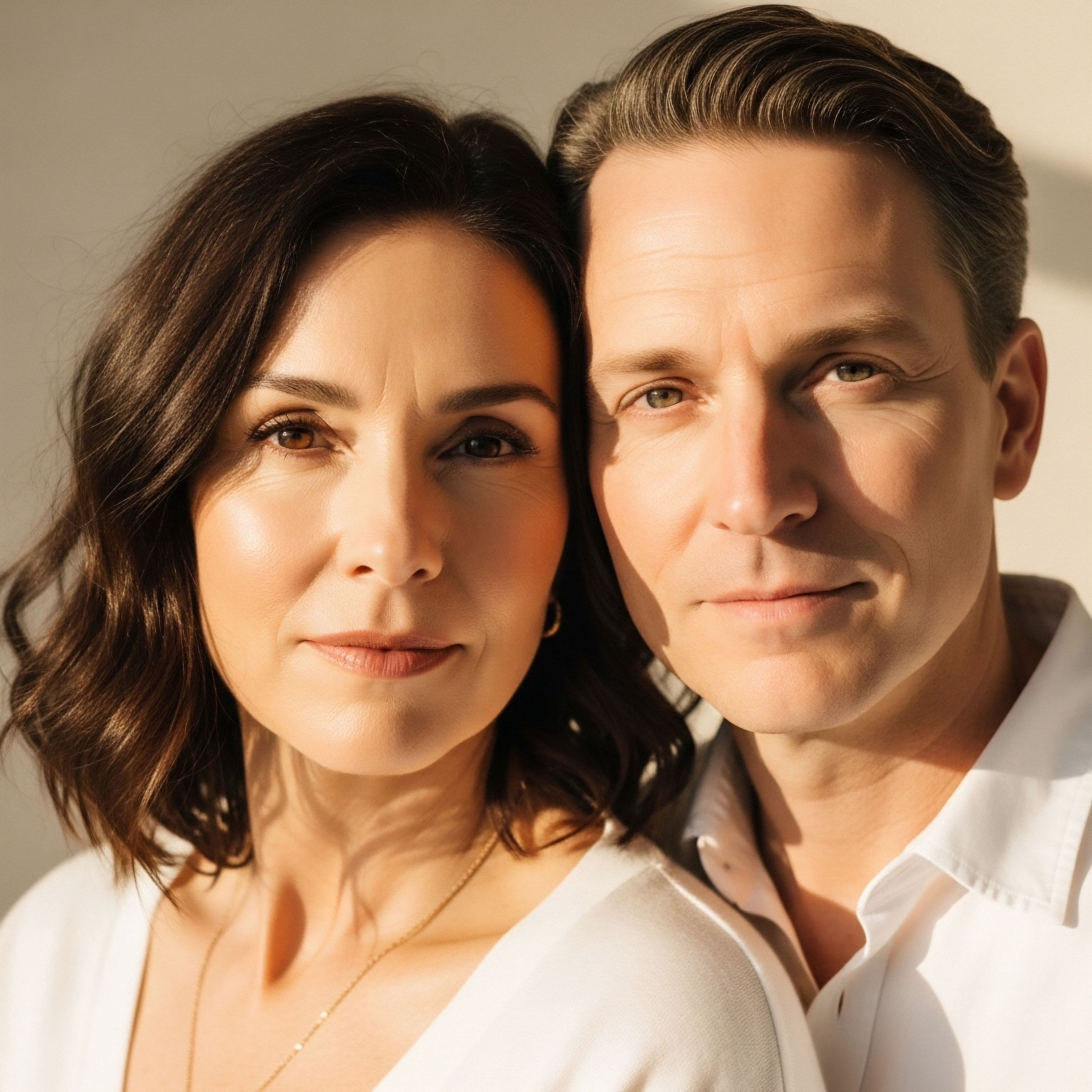

Fundamentals
You may have arrived at a point where the reflection in the mirror seems disconnected from the internal sense of self. A persistent fatigue, a subtle shift in your body’s shape, or a plateau in your physical progress can create a profound sense of frustration.
These experiences are valid signals from your body, a biological language that speaks of complex internal changes. Understanding this language is the first step toward reclaiming your vitality. The conversation begins with your endocrine system, the body’s intricate network of glands and hormones that acts as a master regulator of your physiology.
Think of it as a sophisticated internal messaging service, where hormones are the chemical letters sent through the bloodstream to instruct cells and organs on their specific tasks, from managing energy to building tissue.
At the center of body composition ∞ the ratio of lean mass to fat mass ∞ are key hormonal messengers like testosterone, estrogen, and growth hormone. These molecules are the architects of your physical form. Testosterone, for instance, sends powerful signals to muscle cells to grow and repair, while also influencing where the body stores fat.
Estrogen plays a complementary role, essential for metabolic health and bone density, with its balance being just as important for men as for women. When these hormonal signals are clear, consistent, and balanced, the body functions optimally. When the signals become weak, distorted, or imbalanced due to age or other factors, the body’s architecture begins to change in ways that can feel disheartening.

The Environment of Your Biology
This is where hormonal interventions, such as testosterone replacement therapy (TRT) or peptide therapies, enter the picture. These protocols are designed to restore the hormonal messages to their youthful clarity and strength. A weekly injection of Testosterone Cypionate, for example, is intended to replenish the primary signal for male androgenic function.
Similarly, peptides like Sermorelin or Ipamorelin are designed to encourage the pituitary gland to release its own growth hormone, a powerful agent for tissue repair and metabolic health. These interventions provide the necessary hormonal signal.
The efficacy of these signals, however, is determined by the environment in which they are received. This biological environment is constructed entirely by your lifestyle. The food you consume, the way you move your body, the quality of your sleep, and your management of stress collectively determine how well your cells can “hear” and respond to these restored hormonal messages.
Your daily choices create the foundation upon which any clinical protocol is built. A therapeutic dose of testosterone can be administered, but its ability to build lean muscle is magnified or muted by your actions. The conversation about hormonal optimization is therefore a conversation about the synergistic relationship between clinical science and personal accountability.
Your daily lifestyle choices create the precise biological environment that determines how effectively your body utilizes hormonal interventions.
Consider your body’s cells, particularly muscle and fat cells, as receivers waiting for a signal. The sensitivity of these receivers is a direct result of your lifestyle. Chronic inflammation from a highly processed diet, for instance, can create systemic “static,” making it difficult for cells to register hormonal instructions clearly.
In contrast, a nutrient-dense diet rich in anti-inflammatory foods cleans up the signal. Hormonal interventions supply the message, yet the lifestyle you lead determines the clarity of its reception and the power of its impact. This understanding shifts the perspective from viewing therapy as a passive treatment to seeing it as an active partnership with your own physiology.

How Does Nutrition Modulate Hormonal Pathways?
Nutrition provides the literal building blocks for both hormones and the cellular machinery that responds to them. Hormones like testosterone are synthesized from cholesterol, making healthy fats a non-negotiable component of a supportive diet. Proteins are broken down into amino acids, which are required to build and repair the muscle tissue that testosterone therapy is meant to stimulate.
Carbohydrates, when chosen wisely, replenish glycogen stores to fuel the resistance training that amplifies hormonal effects and are critical for managing the body’s primary metabolic hormone, insulin.
Insulin sensitivity is a cornerstone of hormonal efficacy. A diet high in refined sugars and processed carbohydrates can lead to chronically elevated insulin levels, a state known as insulin resistance. In this state, cells become “numb” to insulin’s message to take up glucose from the blood.
This metabolic dysfunction creates a cascade of problems that directly undermine hormonal therapies. High insulin can lower sex hormone-binding globulin (SHBG), a protein that transports testosterone in the blood. While this may seem to increase “free” testosterone, the underlying metabolic chaos disrupts the entire endocrine system, promoting fat storage and inflammation. Therefore, a nutritional strategy focused on whole foods, balanced macronutrients, and stable blood sugar is not an adjunct to hormonal therapy; it is a prerequisite for its success.


Intermediate
Advancing beyond foundational concepts requires a more granular examination of the direct, mechanistic interplay between lifestyle choices and specific hormonal protocols. When a man begins a standard TRT protocol, such as weekly intramuscular injections of Testosterone Cypionate, he is reintroducing a potent anabolic and androgenic signal into his system.
The goal extends beyond simply elevating serum testosterone levels; the objective is to translate that restored hormonal potential into tangible improvements in body composition, energy, and well-being. This translation process is where lifestyle factors become the active drivers of clinical outcomes. The hormone provides the potential for change, while your physiology, conditioned by your habits, executes the change.
The inclusion of ancillary medications like Anastrozole, an aromatase inhibitor, or Gonadorelin, which helps maintain testicular function, speaks to the complexity of this internal system. Anastrozole’s role is to manage the conversion of testosterone to estrogen, preventing potential side effects like water retention or gynecomastia.
This highlights a critical concept ∞ hormonal balance is a dynamic process. Lifestyle factors, particularly diet and body fat levels, heavily influence aromatase enzyme activity. Higher body fat, for example, is associated with increased aromatase activity, meaning a man with a higher body fat percentage may require more aggressive management of estrogen conversion. A lifestyle geared towards fat loss can therefore reduce the need for ancillary medications and create a more stable internal hormonal environment.

The Synergistic Relationship between Resistance Training and Testosterone Therapy
The relationship between resistance training and testosterone therapy offers a clear example of physiological synergy. Testosterone promotes muscle protein synthesis, the process of repairing and building muscle fibers. Resistance training, particularly heavy compound movements like squats, deadlifts, and presses, creates the stimulus for this synthesis. The mechanical tension placed on muscle fibers during exercise signals a need for repair and adaptation. Testosterone then acts as the primary catalyst for this adaptive process.
This synergy operates at the cellular level through the modulation of androgen receptors (AR). Androgen receptors are proteins located inside muscle cells that bind with testosterone. This binding event is what initiates the downstream cascade of gene expression leading to muscle growth. Research demonstrates that resistance training can increase the density and sensitivity of these androgen receptors.
In practical terms, this means that exercise makes your muscle tissue more “receptive” to the testosterone circulating in your bloodstream. An individual on TRT who engages in consistent resistance training is not just building muscle with exercise; they are fundamentally enhancing their body’s ability to utilize the testosterone being administered. This creates a powerful positive feedback loop ∞ TRT enhances recovery and strength, allowing for more intense training, which in turn upregulates AR sensitivity, making the TRT even more effective.
Effective hormonal therapy relies on lifestyle choices that enhance cellular receptivity to the reintroduced hormonal signals.
This principle extends to women on low-dose testosterone therapy. A protocol of 10-20 units of Testosterone Cypionate weekly is often used to address symptoms like low libido, fatigue, and difficulty maintaining muscle mass. For these women, incorporating resistance training is equally important. It provides the necessary stimulus to direct that testosterone toward building and preserving metabolically active lean tissue, which is crucial for long-term metabolic health, especially through the perimenopausal and postmenopausal transitions.
| Metric | TRT with Sedentary Lifestyle | TRT with Consistent Resistance Training |
|---|---|---|
| Serum Testosterone |
Levels are elevated to therapeutic range. |
Levels are elevated to therapeutic range. |
| Androgen Receptor Sensitivity |
Baseline or potentially downregulated over time. |
Significantly upregulated in muscle tissue. |
| Lean Body Mass |
Modest increases observed due to testosterone’s anabolic properties. |
Substantial increases due to the combination of anabolic signaling and muscle stimulus. |
| Fat Mass Reduction |
Some reduction due to improved metabolic function. |
Accelerated reduction due to increased metabolic rate from higher muscle mass and exercise. |
| Insulin Sensitivity |
Potential for some improvement. |
Markedly improved through both hormonal optimization and direct effects of exercise. |
| Overall Outcome |
Hormonal levels are corrected, with some symptomatic relief. |
Hormonal and physiological systems are optimized, leading to profound changes in body composition and function. |

Sleep and Cortisol the Regulators of Anabolic Potential
The efficacy of any anabolic intervention, whether it’s TRT or growth hormone peptide therapy, is profoundly influenced by the body’s catabolic state, which is primarily governed by the hormone cortisol. Cortisol, produced by the adrenal glands in response to stress, is fundamentally a catabolic hormone; it breaks down tissue to provide energy. While necessary for survival in acute situations, chronically elevated cortisol from poor sleep, psychological stress, or overtraining directly opposes the goals of hormonal therapies for body composition.
Sleep is the primary period of hormonal regulation and tissue repair. During deep sleep (slow-wave sleep), cortisol levels are at their lowest, while the body experiences a natural, significant pulse of growth hormone (GH). This nocturnal GH release is critical for repairing muscle tissue, mobilizing fat for energy, and maintaining overall cellular health.
Sleep deprivation or poor-quality sleep disrupts this delicate balance. It truncates deep sleep, blunting the essential GH pulse, and simultaneously leads to elevated cortisol levels the following day. An individual using a peptide like Ipamorelin/CJC-1295 to stimulate GH release is attempting to augment this natural process.
If that individual is sleeping only 5-6 hours per night, they are creating a high-cortisol, low-GH environment that the peptide must work against. It’s like trying to accelerate a car while the emergency brake is engaged. Prioritizing sleep hygiene is therefore a non-negotiable component of maximizing the return on investment from these advanced protocols.
- Sleep Duration ∞ Aim for 7-9 hours of quality sleep per night. Studies show that even a single night of poor sleep can increase insulin resistance and cortisol.
- Sleep Consistency ∞ Maintaining a regular sleep-wake cycle, even on weekends, helps to anchor the body’s circadian rhythm, which governs the timing of hormone release.
- Light Exposure ∞ Maximize bright light exposure during the day and minimize blue light exposure from screens in the 1-2 hours before bed. This supports the natural production of melatonin, the hormone that initiates sleep.
- Cool Environment ∞ A cool sleeping environment (around 18°C or 65°F) has been shown to improve sleep quality and the metabolic benefits of sleep.
- Stress Management ∞ Implementing stress-reduction practices like meditation, deep breathing, or journaling before bed can lower evening cortisol levels, facilitating an easier transition into restorative sleep.


Academic
A sophisticated analysis of the interplay between lifestyle and hormonal interventions requires moving beyond systemic effects to the molecular and genetic levels. The clinical response to an identical protocol of hormonal therapy can vary significantly among individuals, and this variability is often rooted in cellular biology that is itself modulated by lifestyle.
The efficacy of Testosterone Replacement Therapy (TRT), for instance, is a function of not only supraphysiological hormone delivery but also the transcriptional activity it initiates within target cells. This process is contingent upon the density, sensitivity, and genetic makeup of the androgen receptor (AR), a key locus where lifestyle and genetics converge to determine therapeutic outcomes.
The administration of exogenous testosterone elevates the ligand concentration available to bind with the AR. However, the downstream anabolic signaling cascade ∞ involving the translocation of the testosterone-AR complex to the cell nucleus and the subsequent activation of androgen-responsive genes ∞ is a rate-limited process.
This rate is influenced by factors like the phosphorylation status of the receptor and the presence of co-activator proteins, both of which can be modulated by the intracellular environment. This environment is a direct reflection of metabolic health, which is governed by lifestyle.
For example, the state of cellular energy, signaled by pathways like AMPK (AMP-activated protein kinase), and the inflammatory milieu, signaled by pathways like NF-κB (nuclear factor kappa-light-chain-enhancer of activated B cells), can influence AR activity. A lifestyle that promotes chronic inflammation and poor glycemic control creates an intracellular environment that is suboptimal for androgenic signaling, thereby attenuating the potential benefits of TRT.

Androgen Receptor Polymorphism a Genetic Determinant of TRT Response
The genetic architecture of the androgen receptor itself introduces another layer of complexity. The AR gene contains a polymorphic region known as the CAG repeat sequence. The length of this repeat, which varies among individuals, has been shown to inversely correlate with the transcriptional activity of the receptor.
A shorter CAG repeat length is associated with a more sensitive androgen receptor, leading to a more robust response to a given level of testosterone. Conversely, a longer CAG repeat length is associated with a less sensitive receptor. This genetic predisposition can help explain why two men on identical TRT protocols, with identical serum testosterone levels, might experience different degrees of change in lean body mass or strength.
This genetic factor does not exist in a vacuum. It interacts with the lifestyle-driven physiological environment. An individual with a genetically less sensitive AR (longer CAG repeat) might require a more optimized lifestyle ∞ particularly rigorous resistance training and impeccable insulin sensitivity ∞ to achieve the same clinical outcome as an individual with a more sensitive receptor.
Resistance training’s ability to increase AR density becomes even more critical for this individual, as it provides a compensatory mechanism to overcome lower intrinsic receptor sensitivity. This illustrates a key principle of personalized medicine ∞ understanding an individual’s genetic predispositions allows for the strategic application of lifestyle interventions to maximize the efficacy of a standardized clinical protocol.
The molecular dialogue between hormones and their receptors is profoundly influenced by the cellular environment, which is sculpted by nutrition, exercise, and sleep.
This deepens the clinical conversation. It moves from simply monitoring serum hormone levels to considering the entire signaling pathway, from ligand availability to genetic transcription. It underscores the idea that lifestyle interventions are not merely supportive; they are integral components of the therapeutic strategy, capable of modulating outcomes at the most fundamental levels of molecular biology.
| Intervention | Primary Molecular Target | Synergistic Lifestyle Factor | Mechanism of Synergy |
|---|---|---|---|
| Testosterone Cypionate |
Androgen Receptor (AR) |
Resistance Training |
Increases AR density and phosphorylation in skeletal muscle, enhancing transcriptional response to testosterone. Improves insulin sensitivity, reducing systemic inflammation that can impair AR function. |
| Ipamorelin / CJC-1295 |
Pituitary Ghrelin Receptor (GHSR) |
Maximizes the natural nocturnal GH pulse that the peptide augments. Lowers cortisol, creating a more favorable anabolic-to-catabolic ratio for GH to act upon. |
|
| Anastrozole |
Low Body Fat / Healthy Diet |
Reduces adipose tissue, the primary site of extragonadal aromatase activity. Certain phytonutrients (e.g. from cruciferous vegetables) can also influence estrogen metabolism pathways. |
|
| Tesamorelin |
Growth Hormone-Releasing Hormone Receptor (GHRH-R) |
Caloric Deficit / Diet |
Specifically approved for visceral adipose tissue (VAT) reduction. Its fat-mobilizing effects are amplified when combined with a nutritional strategy that prevents the re-storage of mobilized fatty acids. |

How Does the Hypothalamic Pituitary Adrenal Axis Impact Gonadal Function?
The human endocrine system is a network of interconnected feedback loops, not a collection of isolated vertical pathways. The efficacy of interventions targeting the Hypothalamic-Pituitary-Gonadal (HPG) axis, such as TRT or therapies like Clomid and Gonadorelin, is directly influenced by the status of the Hypothalamic-Pituitary-Adrenal (HPA) axis, the body’s central stress response system.
Chronic activation of the HPA axis, driven by poor sleep, psychological stress, or systemic inflammation, leads to sustained secretion of Corticotropin-Releasing Hormone (CRH) from the hypothalamus and, subsequently, cortisol from the adrenal glands.
CRH and cortisol exert a direct inhibitory effect on the HPG axis at multiple levels. CRH can suppress the release of Gonadotropin-Releasing Hormone (GnRH) from the hypothalamus. Cortisol can reduce the sensitivity of the pituitary gland to GnRH and directly suppress testosterone production in the testes.
This creates a state of functional hypogonadism. In a clinical context, this means that an individual with a chronically activated HPA axis may find that their TRT protocol is less effective or requires higher doses to achieve the desired effect. They are essentially fighting against a powerful, internally generated, anti-gonadal signal.
Lifestyle interventions aimed at mitigating HPA axis activation ∞ such as mindfulness practices, adequate sleep, and proper nutrition ∞ are therefore direct interventions in support of HPG axis function. They work to lower the physiological “noise” that interferes with the intended hormonal signal, allowing therapies to work more efficiently within a balanced and receptive system.
- HPA Axis ∞ The body’s central stress response system, involving the hypothalamus, pituitary gland, and adrenal glands, culminating in cortisol release.
- HPG Axis ∞ The reproductive axis, involving the hypothalamus, pituitary gland, and gonads (testes or ovaries), responsible for regulating sex hormone production.
- Inhibitory Crosstalk ∞ Hormones from a chronically activated HPA axis (like cortisol) can suppress the function of the HPG axis at every level, from the brain to the gonads.
- Clinical Implication ∞ Managing stress and sleep is a primary therapeutic strategy for supporting gonadal function and maximizing the efficacy of hormonal interventions like TRT.

References
- Bhasin, Shalender, et al. “Testosterone Therapy in Men with Androgen Deficiency Syndromes ∞ An Endocrine Society Clinical Practice Guideline.” The Journal of Clinical Endocrinology & Metabolism, vol. 103, no. 5, 2018, pp. 1715 ∞ 1744.
- Davis, Susan R. et al. “Testosterone Use in Postmenopausal Women ∞ A Consensus Statement from The North American Menopause Society, The Endocrine Society, and the International Menopause Society.” The Journal of Clinical Endocrinology & Metabolism, vol. 104, no. 11, 2019, pp. 4660 ∞ 4666.
- Leproult, Rachel, and Eve Van Cauter. “Role of Sleep and Sleep Loss in Hormonal Release and Metabolism.” Endocrine Reviews, vol. 26, no. 4, 2005, pp. 513-543.
- Zitzmann, Michael. “Mechanisms of Disease ∞ Pharmacogenetics of Testosterone Replacement Therapy.” Nature Clinical Practice Endocrinology & Metabolism, vol. 3, no. 5, 2007, pp. 426-435.
- Vingren, Jakob L. et al. “Testosterone Physiology in Resistance Exercise and Training.” Sports Medicine, vol. 40, no. 12, 2010, pp. 1037-1053.
- Spiegel, Karine, et al. “Impact of Sleep Debt on Metabolic and Endocrine Function.” The Lancet, vol. 354, no. 9188, 1999, pp. 1435-1439.
- Traish, Abdulmaged M. et al. “The Dark Side of Testosterone Deficiency ∞ I. Metabolic Syndrome and Erectile Dysfunction.” Journal of Andrology, vol. 30, no. 1, 2009, pp. 10-22.
- Storer, Thomas W. et al. “Testosterone Dose-Dependently Increases Fat-Free Mass and Muscle Size in Healthy Young Men.” The Journal of Clinical Endocrinology & Metabolism, vol. 86, no. 11, 2001, pp. 5108-5115.
- Poehlman, Eric T. and M. J. Toth. “The Menopausal Transition, Adiposity, and Cardiovascular Risk.” Annals of the New York Academy of Sciences, vol. 904, no. 1, 2000, pp. 359-365.
- Rao, M. N. et al. “Sleep and the Hypothalamo-Pituitary-Adrenal Axis.” Sleep Medicine Reviews, vol. 12, no. 2, 2008, pp. 147-160.

Reflection

Listening to Your Body’s Dialogue
The information presented here provides a map of the intricate biological landscape that defines your health. It details the chemical messengers, the cellular receivers, and the powerful influence of your daily choices. This knowledge serves as a powerful tool, shifting the perspective from one of passive recipient to active participant in your own wellness journey.
The science confirms what you may have intuitively felt ∞ that your body is a responsive, interconnected system. Every meal, every workout, and every night of rest is a form of communication with your own biology. The question now becomes a personal one. What is your body communicating to you through its symptoms and signals?
Consider the patterns in your own life. Where is there synergy, and where is there friction? Is your lifestyle creating an environment of clear communication, or one of systemic static? The path to optimized health is one of continuous adjustment and learning, a dialogue between your actions and your body’s response.
The data from a lab report provides one part of the story; your lived experience provides the other. Armed with a deeper understanding of the mechanisms at play, you are now better equipped to listen to that dialogue and make informed, intentional choices that align your actions with your ultimate goals for vitality and function.



